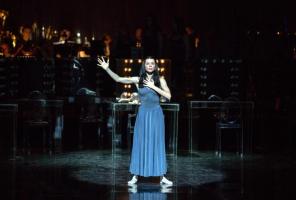Mastery and Individuality of the Dancer
Ballet is a form of theatrical art. Theater is a world where we invite the audience into our performance, into our story, even when the ballet lacks a narrative line. A role often requires not only technical and acting preparation but also an understanding of the character, of life experience.
How can one determine if a dancer is ready to fulfill this task? To lead the audience through the performance, infusing the choreographic text with their own nuances, their individuality? How does one cultivate this individuality?
Lately, it’s become increasingly common to see mediocre performers in solo roles in ballet productions. Technically insufficient, and lacking in acting—so to speak, “gray.”
One can’t help but recall how dancers of past generations prepared for their roles in performances. How challenging it was for them to receive their assignments from the ballet directors. The extensive process they underwent with their repetiteurs. How long they prepared for their debut. The joy they felt from the work accomplished, from a successful debut. What has changed?
A talented young woman or man joins the company. Nurturing this talent into a soloist is the responsibility of the artistic director and the repetiteurs. The process is not simple; only a skillful, gradual introduction into the solo repertoire can lead to a positive result. Here, the repetiteurs become the most crucial people. It is they who can accurately assess the technical capabilities and growth of the dancer, sometimes advocating for the necessity of a role assignment, and other times, persuading the troupe leader to hold off.
Performing a leading role is not just a series of technical elements; it’s a small life lived on stage. A life that the audience must believe in and experience alongside the action that unfolds on stage.
Often, we rush to give roles to young dancers. We justify their lackluster performance on stage with their youth, the limited number of rehearsals, or the shortage of dancers in the troupe. This mediocrity carries over from one performance to the next; the execution of technical elements remains poor, and the acting interpretations of the role are uninteresting. But this often alters the young talent’s attitude toward work. The carefree behavior of a young “star” hinders the work. Losing contact with the repetiteurs, ignoring feedback, losing the drive for discovery—these are the results, and many end up looking like retired dancers before they even reach thirty.
Of course, I may be painting a bleak picture. Many young, talented people achieve great success. Many never get that “juicy opportunity”—the chance to try. Many get lost waiting for hope. They never met their choreographer, never had a repetiteur who believed in them, or they missed their chance.
For me, the responsibility toward young dancers lies first and foremost with the repetiteurs. The ability to see, understand, and nurture is a gift essential for a repetiteur. Patience and hard work, the process I wrote about in my last letter.
I love working with the young. Many of those I believed in now grace not only the stage of the theater where I serve, and the success of all those I’ve worked with always brings me joy. The joy of knowing I did not make a mistake, that I correctly guided them to leading roles. After all, this creative journey takes years—years spent together, wherever the dancers may be today.
To conclude this letter, a bit of history from the Russian Imperial Theater. A fragment I hold dear from the memoirs of Matilda Kschessinskaya about her conversation with Marius Ivanovich Petipa:
“After listening to my request about the ballet ‘Esmeralda,’ he asked: ‘Have you ever been in love?’ I enthusiastically replied that I was in love and loved. Then he asked a second question: ‘Have you ever suffered?’ This question seemed strange to me, and I immediately answered: ‘Of course not.’ Then he told me something I often recalled later. He explained that only by experiencing the sufferings of love could one truly understand and perform the role of Esmeralda. How bitterly I later remembered his words, after suffering the right to dance Esmeralda, and she became my best role.”
© Konstantin Uralsky
